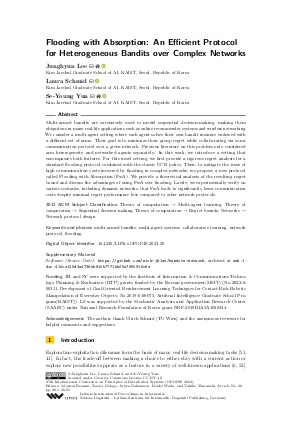@InProceedings{lee_et_al:LIPIcs.OPODIS.2023.20,
author = {Lee, Junghyun and Schmid, Laura and Yun, Se-Young},
title = {{Flooding with Absorption: An Efficient Protocol for Heterogeneous Bandits over Complex Networks}},
booktitle = {27th International Conference on Principles of Distributed Systems (OPODIS 2023)},
pages = {20:1--20:25},
series = {Leibniz International Proceedings in Informatics (LIPIcs)},
ISBN = {978-3-95977-308-9},
ISSN = {1868-8969},
year = {2024},
volume = {286},
editor = {Bessani, Alysson and D\'{e}fago, Xavier and Nakamura, Junya and Wada, Koichi and Yamauchi, Yukiko},
publisher = {Schloss Dagstuhl -- Leibniz-Zentrum f{\"u}r Informatik},
address = {Dagstuhl, Germany},
URL = {https://drops.dagstuhl.de/entities/document/10.4230/LIPIcs.OPODIS.2023.20},
URN = {urn:nbn:de:0030-drops-195100},
doi = {10.4230/LIPIcs.OPODIS.2023.20},
annote = {Keywords: multi-armed bandits, multi-agent systems, collaborative learning, network protocol, flooding}
}

 Creative Commons Attribution 4.0 International license
Creative Commons Attribution 4.0 International license








